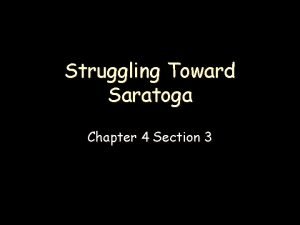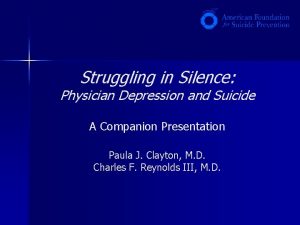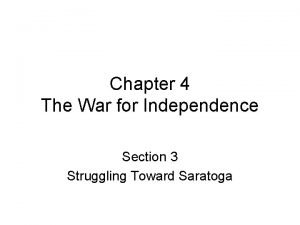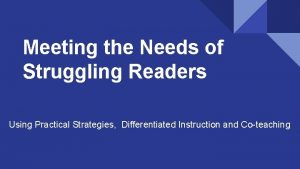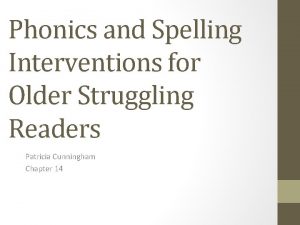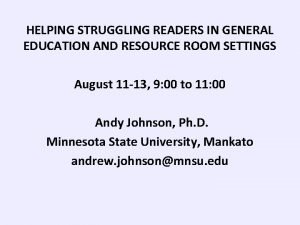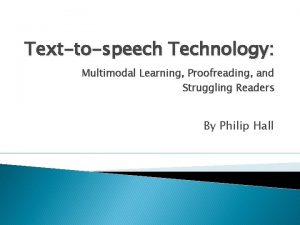Struggling readers and gender Are we meeting the








- Slides: 8

Struggling readers and gender Are we meeting the needs of all learners? Sandy Levecque EDU 744

What does research have to say about struggling male readers? • • • “The NAEP reveals that the gap observed between reading scores of fourth-grade males and females in previous years continues to be significant was larger in 2000 than in 1998. ” (Taylor, 2005) “. . . the typical boy in the United States lags a year and one-half behind the typical girl. ” (Kleinfeld, 2006) “. . . data analysis also revealed that boys who are average readers are less motivated to read, and specifically that they value reading less than girls who are average readers. ” (Marinak and Gambrell, 2010) My experience: In my twelve years of teaching, the majority of struggling readers I’ve worked with have been male. This year, I have nine struggling readers in my class. Five of them are boys. Being able to find a way to hook a struggling student makes all the difference. A major key to unlocking reading for them is a matter of matching them with the right reading material.

How do we help close the gap? Marinak and Gambrell (2010) suggest that motivation and the value assigned to the task is of critical importance. Since some boys don’t value reading, we need to increase the value of the task. Providing better matched material and more authentic tasks are two strategies suggested. Parsons (2004) begins by looking at the gender gap, but moves into standard reading practices. He lists ten practices that are highly effective for all learners, not just boys. He includes significant time to read and self-selecting appropriate material. He also mentions the opportunity to respond to texts and the chance to discuss what they are reading. Taylor (2005) relies heavily on the different texts to which student are exposed. She makes her case with the example of her son, who felt he was a poor reader. Her son was able to read technical manuals and internet instructions. He didn’t do well with the novels in his reading class, leading him to believe he was a poor reader. Jenkins (2009) offers suggestions about allowing students to self-select texts and providing them with texts that connect to their world. He also favors consistency from year to year. One teacher could brief the next or continue working with the same student.

Synthesis Expectancy-Value Theory looks at the value a student places on a task and their expectation to succeed at that task. Each one of the articles highlights this theory. Marinak and Gambrell (2010) clearly state that we need to increase the value of reading as a task. Parsons (2004) writes “When students, regardless of gender, are finally convinced that reading can help them cope with and make sense of their world and their lives, inevitably, the reading will flow. ” (p. 11) The sad truth in Taylor’s (2005) article was that her son’s perception was that he was a poor reader. This was such an overwhelming factor that he chose to leave school and complete his GED. While he is a very successful technical reader, the emphasis on fiction made him feel less able, decreasing his motivation to continue. Linking text to real world events would definitely increase the value of reading for many struggling students. Both Taylor (2005) and Jenkins (2009) suggests this as one strategy to help those readers. Each of these authors lean toward motivation theory in order to better help struggling male readers succeed. Increasing reader expectation of success and allowing them to find reading material they value will have a positive impact.

Critical analysis While these articles have many differences, common themes and ideas emerge. Varying read alouds and introducing exciting authors are two key strategies. I try to make sure I read several adventure books with male characters. I’ve found Anthony Horowitz, Greg Taylor, Jon Sceiszka, and Harry Mazer hook boys. Both Parson (2004) and Marinak and Gambrell (2010) mention the correlation between student preference and the typical assigned reading that students may not value. In order to further increase the value, we should encourage all kinds of reading. Taylor (2005) explained that her son was able to read complicated technical manuals, but did not believe this was actual reading. We also need to get them talking about books. Seeing other students and adults excited about reading provides struggling readers with excellent models. Taylor (2005) also suggests inviting men into the classroom to book talk. Finally, we need to bolster our readers’ perception of their strength. When we spend too much time concentrating on those struggles, they begin to believe that there aren’t those strengths. If we can show them the positives, it will build their expectation of success. Those two elements can make a world of difference. Jenkins (2009) strongly supports this idea with a recommendation about building on past successes.

Conclusion Working with struggling readers is akin to solving a complex jigsaw puzzle. One of the major pieces of this puzzle is motivation theory. I frequently use bicycle riding as a metaphor when we hit a rough patch. I’ll ask them if they just got onto the bike and road perfectly the first time. The reasoning is the more they practice, they more skilled they became. The same holds true of reading. Another major key is finding the material that makes them want to read. They need to be able to connect to the material and find value in reading it. Exposing students to a wide variety of genres can help them find that material that may help put this puzzle together for them.

My questions for the group: • • • Have you noticed if more of your struggling readers are male? If so, do you have any strategies that you feel have been successful? Do you have specific authors you use to try to hook struggling male readers? Do you use the internet as a source for alternative reading material? Do you have any site suggestions?

References: Jenkins, S. (2009). How to maintain school reading success: Five recommendations from a struggling male reader. The Reading Teacher, 63(2), 159 -162. Retrieved from http: //search. proquest. com/docview/203288703? accountid=12756 Kleinfeld, J. (2006, June). Five powerful strategies for connect boys to schools. Paper presented at the White House Conference on Helping America’s Youth, Indianapolis, IN. Retrieved from: http: //www. singlesexschools. org/Kleinfeld. htm Marinak, B. A. , & Gambrell, L. B. (2010). Reading Motivation: Exploring the Elementary Gender Gap. Literacy Research And Instruction, 49(2), 129 -141 DOI: 10. 1080/19388070902803795 Parsons, L. (2004). Challenging the gender divide: Improving literacy for all. Teacher Librarian, 32(2), 8 -11. Retrieved from http: //search. proquest. com/docview/224877500? accountid=12756 Taylor, D. L. (2005). "Not just boring stories": Reconsidering the gender gap for boys. Journal of Adolescent & Adult Literacy, 48(4), 290 -298. Retrieved from http: //search. proquest. com/docview/216915018? accountid=12756
 The outsiders adapted for struggling readers
The outsiders adapted for struggling readers Insidan region jh
Insidan region jh Compare non-critical readers with critical readers.
Compare non-critical readers with critical readers. Strategic gender needs and practical gender needs
Strategic gender needs and practical gender needs Chapter 4 section 3 struggling toward saratoga
Chapter 4 section 3 struggling toward saratoga Struggling in silence
Struggling in silence Remediation of the struggling medical learner
Remediation of the struggling medical learner Chapter 4 section 3 struggling toward saratoga
Chapter 4 section 3 struggling toward saratoga What is meeting and types of meeting
What is meeting and types of meeting




